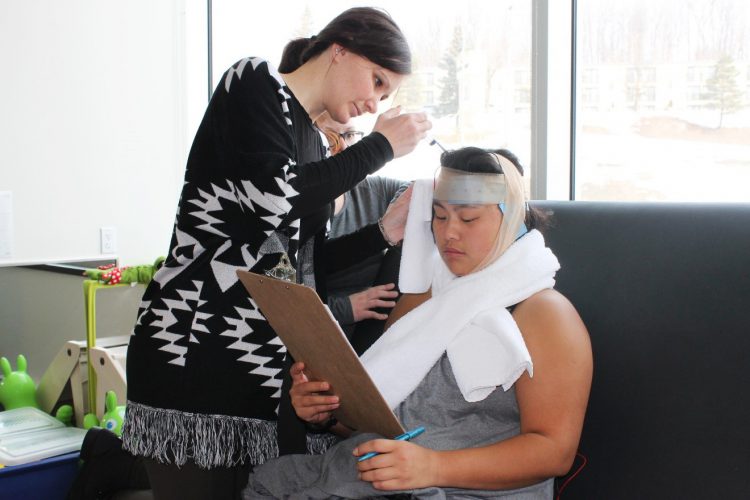
Transcranial direct current stimulation (tDCS)

Transcranial direct current stimulation (tDCS) is a non-invasive method that stimulates the brain with electrodes placed on the scalp. An low-intensity electrical current circulates from one electrode to another, which allows the excitability of brain cells to be changed and persistent pain to be reduced.
During treatments, healthcare professionals use carbon electrodes which are inserted into sponges that are moistened with a saline solution. The electrodes are then deposited on the scalp and held in place with straps. The cathode is placed in the motor cortex (right or left, from the opposite side of the patient’s main pain) and the cathode on the forehead, on the opposite side. Approximately 50% of the current emitted by the device (2 mA) reaches the brain tissue. The rest of the current dissipates at the level of the skin and bones of the skull. The current enables cortical excitability to be adjusted in certain regions of the brain in order to stimulate the mechanisms of pain deceleration.
The increase or decrease in excitability can vary according to the protocol and installation of electrodes: the anode allows for an increase and the cathode, a decrease.
Who should use tDCS?
These treatments aim to reduce chronic pain, including:
- Nociceptive pain (ex.: persistant musculoskeletal injuries)
- Neuropathic pain (ex.: post-AVC pain, radiculopathy)
- Mixed pains (ex.: lombosciatalgia)
- Functional pain (ex.: fibromyalgia)
In practical terms: quite a few!
A tDCS session in physiotherapy lasts about 45 minutes, including the installation of electrodes, 20 minutes of stimulation, and 15 minutes of therapeutic exercises. Everything is repeated for 5 consecutive days. The increase in cortical excitability produced by the stimulation can last longer than the duration of the stimulation. It is therefore essential to take advantage of the post-stimulation effect to complete therapeutic exercises. Relief from pain is generally perceived after 2 or 3 sessions, and its effect tends to increase after 5 sessions, and in the weeks following the treatments.
You do not need a medical prescription to have access to tDCS treatments. Contact can be made with your family doctor or referral (specialist) to inform them and follow up on the treatment via courrier.
Contraindications
Patients must first be evaluated by a physiotherapist in order to learn if tDCS applies to their condition. Some contraindications exist, such as:
- Pregnancy
- Previous surgery on the head
- The presence of a brain tumor
- The present of neurological or neuropsychiatric disorders
- The presence of metal plates on the skull (excluding fillings)
- Wearing stimulators or electronic implants (ex.: pacemaker)
- Suffering from epilepsy or having suffered recent or severe cranial trauma
Potential adverse effects of tDCS treatment:
- tDCS generally does not cause adverse effects; when these do occur, they remain minimal (light headaches and fatigue) and short-term
- The tDCS treatment is not painful
tDCS could be for you if:
- You have persistant pain
- You would like to find something to complement medication to treat your pain
- You would like to improve pain management in order to optimize your physical capabilities
For more information, don’t hesitate to reach out to one of our physiotherapists: Amélie Boucher, Catherine Apinis, Antoine Laramée and Guillaume Léonard would be happy to discuss this treatment option with you.


